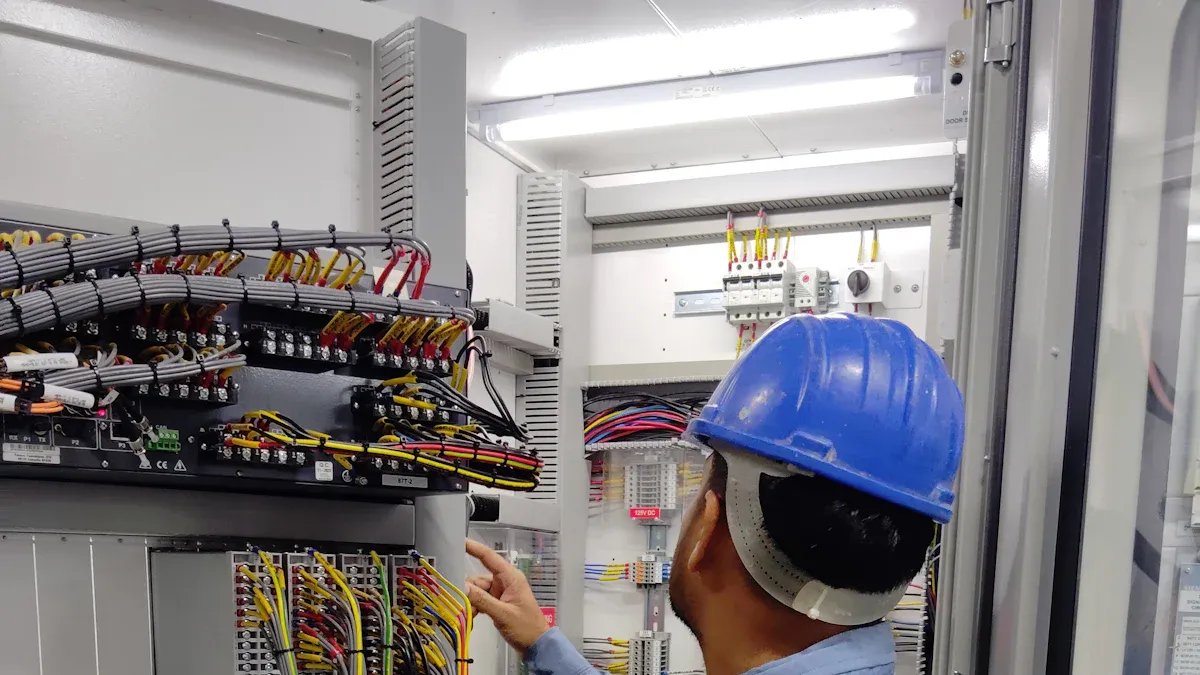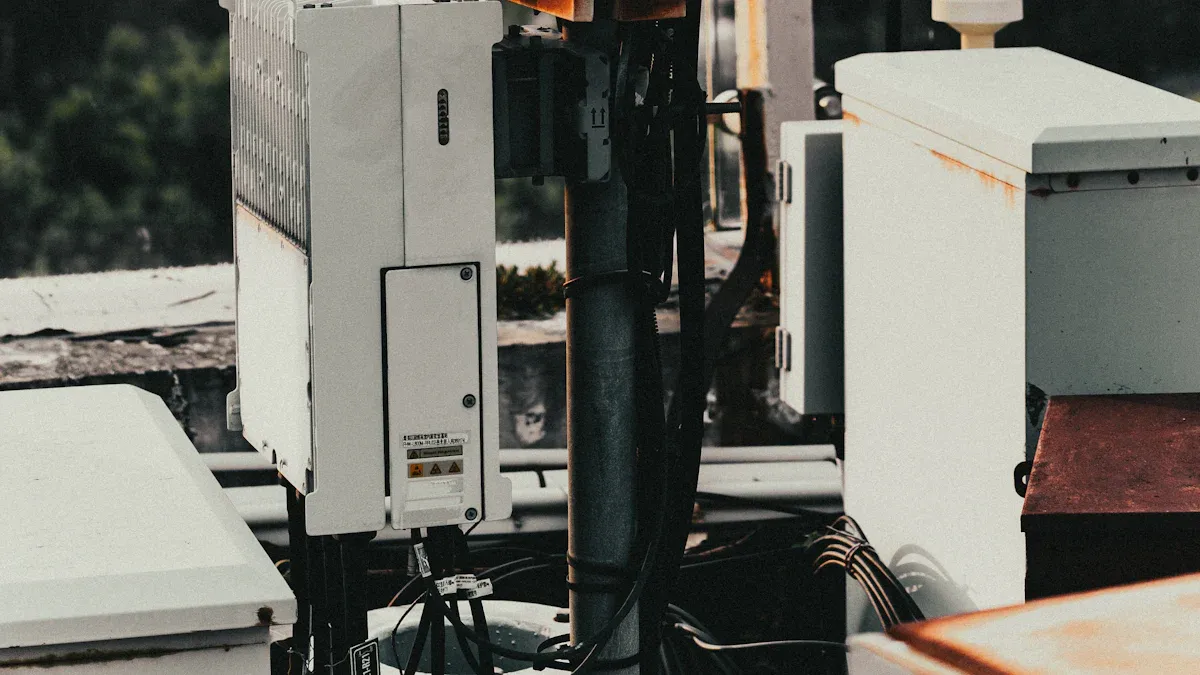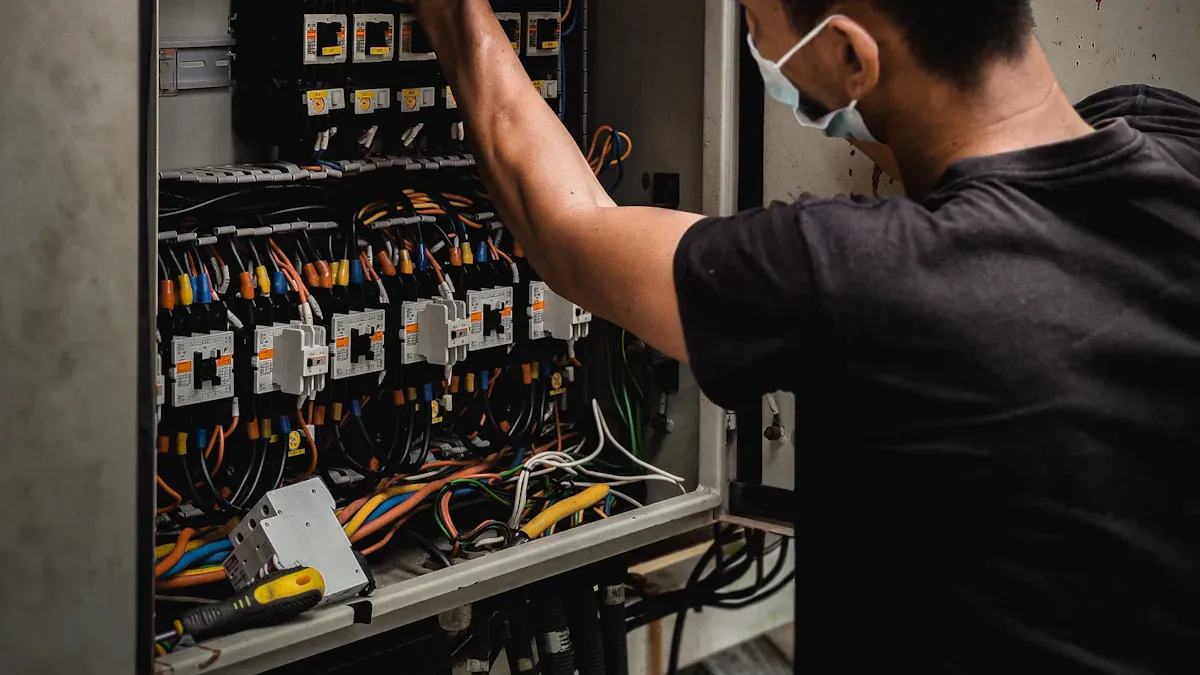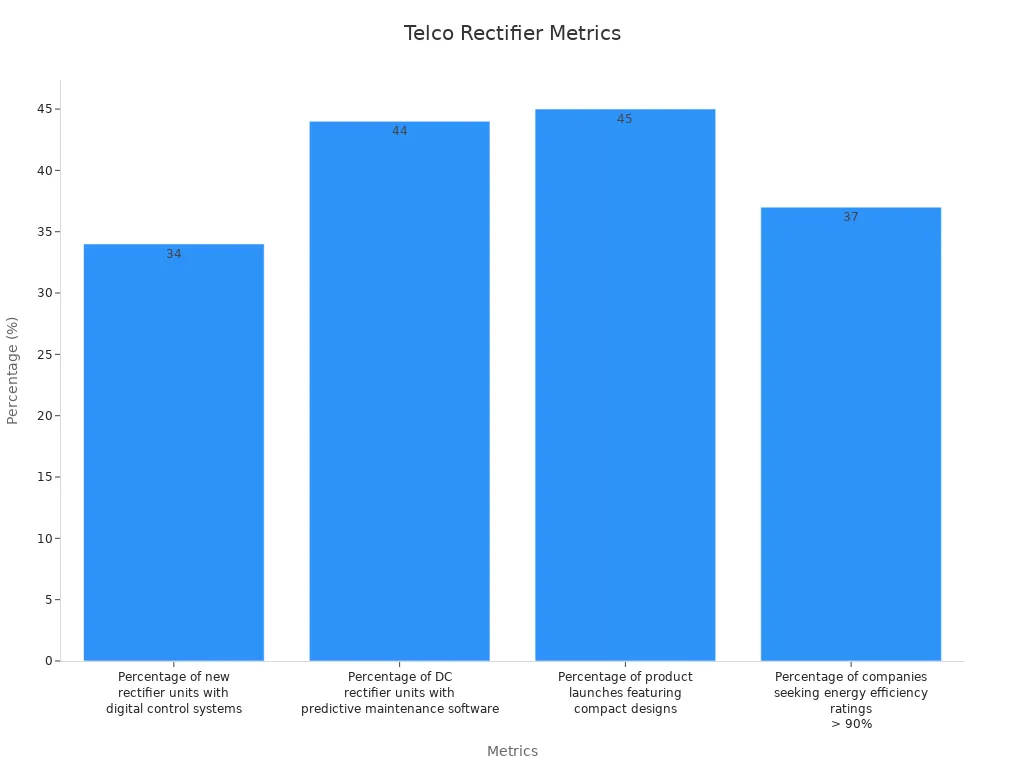Top Trends in Telecom Rectifier Cabinet Technology by ESTEL

Telecom rectifier cabinets represent a critical element in powering telecommunications systems. These cabinets deliver reliable power to telecom networks, ensuring seamless operations even under extreme conditions. With over 500,000 systems deployed globally and 2,400,000 rectifier modules achieving near 97% efficiency, they exemplify energy-efficient design. Industry leaders aim to push efficiency levels closer to 98%, setting new benchmarks for sustainability. Built for durability, these systems can operate for more than 15 years while adapting to fluctuating power demands. Their advanced monitoring tools detect issues early, minimizing downtime and enhancing network reliability.
Key Takeaways
Telecom rectifier cabinets change AC power to DC power. They give steady power to telecom systems and work during power outages.
Saving energy is important. New rectifiers are over 90% efficient. This saves money and helps the environment.
Modular designs make it easy to add or fix parts. Telecom companies can grow networks without replacing everything.
AI and IoT make systems smarter. They guess power needs and check systems in real-time, making them work better.
Being eco-friendly matters. Using renewable energy in rectifiers helps the planet and uses less regular electricity.
Overview of Telecom Rectifier Cabinet Technology
Defining Telecom Rectifier Cabinets
A telecom rectifier cabinet is a critical component of modern telecom power systems. It converts alternating current (AC) into direct current (DC), providing stable and efficient power to telecom systems. These cabinets are designed to meet the high energy demands of telecom infrastructure, ensuring uninterrupted operations. By integrating advanced rectifier modules, they achieve remarkable efficiency levels, with some systems reaching up to 99% efficiency. This efficiency not only reduces energy consumption but also minimizes operational costs, making them indispensable in the telecom industry.
Importance in Telecom Infrastructure
Telecom rectifier cabinets play a pivotal role in maintaining the reliability of telecom infrastructure. They ensure consistent power delivery to critical systems, even during power fluctuations or outages. With the rapid expansion of 5G and 6G networks, the demand for robust telecom power systems has surged. These cabinets support the deployment of small cells and edge computing nodes, which are essential for high-speed connectivity. Additionally, their modular designs allow for scalability, enabling telecom operators to adapt to evolving network requirements. The global usage of over 500,000 rectifier systems highlights their significance in powering telecom systems worldwide.
Technological Evolution of Rectifier Cabinets
The evolution of telecom rectifier cabinets reflects the industry's commitment to innovation and sustainability. Early designs focused on basic AC to DC conversion, but modern systems incorporate advanced features like high power density and smart monitoring. For instance, some rectifiers now achieve power densities of 73 W/in³, making them ideal for compact installations. Efficiency improvements have also been significant, with energy savings of up to 30% and a 40% reduction in carbon emissions. Research has shown that 380-V DC systems outperform traditional AC systems, particularly when integrated with renewable energy sources. These advancements have not only enhanced the reliability of telecom power systems but also contributed to the growth of the telecom power system market, which is projected to reach $36.72 billion by 2032.
Key Trends in Telecom Rectifier Cabinet Technology in 2025

Energy Efficiency and Smart Power Solutions
Energy efficiency remains a cornerstone of telecom rectifier cabinet innovation. High-efficiency rectifiers now achieve performance levels exceeding 90%, with some advanced rectifiers designed to surpass this benchmark. These energy-efficient technologies minimize energy waste, leading to significant cost savings and reduced environmental impact. For instance, a major telecom provider recently modernized its telecom power system, achieving substantial carbon emission reductions and annual savings over five years. This demonstrates the effectiveness of energy-saving solutions in enhancing operational efficiency.
Smart rectifiers equipped with intelligent power optimization features are transforming telecom systems. These systems dynamically adjust power output based on real-time demand, ensuring optimal energy usage. The integration of smart power solutions not only supports energy efficiency but also aligns with the growing adoption of renewable energy sources. The telecom power system market, projected to grow at a compound annual growth rate (CAGR) of 11.0% from 2025 to 2032, highlights the increasing demand for such innovations.
Modular and Scalable Cabinet Designs
Modular rectifiers are revolutionizing the telecom industry by offering unparalleled flexibility and scalability. These designs allow telecom operators to expand their power systems seamlessly as network demands grow, eliminating the need for complete system replacements. A closer look at design performance metrics reveals the following advantages:
Metric | Description |
|---|---|
Scalability | Enables easy expansion of power systems without replacing the entire setup. |
Reliability | Ensures uninterrupted operation even if one module fails, reducing service interruptions. |
Reduced Downtime | Allows repairs on individual modules without halting the entire system. |
Energy Efficiency | Facilitates integration with renewable energy sources, reducing reliance on traditional grids. |
In addition to these benefits, modular designs contribute to cost savings. Comparative data shows that modular rectifiers operate at mid to high 90% efficiency levels, significantly outperforming traditional methods. GreenConnect, for example, reported a 30% reduction in energy usage after adopting ESTEL's modular rectifiers, resulting in substantial financial savings. These advancements underscore the importance of modularity in modern telecom power systems.
AI and IoT Integration in Telecom Rectifiers
Artificial intelligence (AI) and the Internet of Things (IoT) are reshaping the landscape of telecom rectifiers. By leveraging AI algorithms, telecom systems can predict power demand patterns, optimize energy distribution, and identify potential issues before they escalate. IoT-enabled rectifiers provide real-time monitoring and remote management capabilities, enhancing operational efficiency and reducing maintenance costs.
The integration of AI and IoT also supports the deployment of 5G networks, which require highly reliable and efficient power systems. Smart rectifiers equipped with IoT sensors can monitor environmental conditions, such as temperature and humidity, to ensure optimal performance. This level of innovation not only enhances network reliability but also aligns with the industry's shift toward smarter, more connected telecom infrastructure.
Sustainability and Renewable Energy Integration
Sustainability has become a cornerstone of telecom rectifier cabinet innovation. In 2025, the integration of renewable energy sources into telecom rectifiers is driving significant advancements in energy-efficient technologies. These systems now support solar, wind, and other green energy solutions, reducing reliance on traditional power grids. By leveraging modular designs, telecom operators can seamlessly incorporate renewable energy systems into their infrastructure, enhancing both scalability and environmental impact.
📈 Impactful Data:
Recent studies highlight the transformative effects of renewable energy integration in telecom rectifiers.
Improvement Type | Percentage Change | Impact |
|---|---|---|
Energy Savings | 30% | Significant cost savings |
Carbon Footprint Reduction | 40% | Supports global climate goals |
Improved Reliability | 25% | Reduces service downtime |
These improvements underscore the growing importance of sustainability in telecom technology. By reducing carbon emissions and optimizing energy usage, telecom rectifier cabinets contribute to global climate goals while enhancing operational reliability.
Smart rectifiers play a pivotal role in this transition. Equipped with intelligent power optimization features, they dynamically adjust energy output based on real-time demand. This capability ensures efficient energy utilization, particularly when paired with renewable sources. As telecom networks expand to support 5G and 6G technologies, the demand for sustainable power solutions continues to rise.
Advanced Cooling and Thermal Management Systems
Efficient cooling systems are essential for maintaining the performance and reliability of telecom rectifiers. Advanced thermal management technologies have emerged as critical components in ensuring optimal operating temperatures, even under heavy loads. These systems utilize sophisticated algorithms to monitor and control heat dissipation, preventing overheating and reducing the likelihood of component failure.
💡 Technical Insights:
Advanced cooling systems integrated into telecom rectifiers deliver exceptional performance metrics.
Metric | Value |
|---|---|
Energy Efficiency (Rectifier) | Exceeds 96% |
Energy Efficiency (Inverter) | Above 96% at max power |
Substation Converter Efficiency | Over 97% at max power |
Power Density Improvement | 10% better than discrete solutions |
Package Inductance Reduction | 16% reduction |
These systems incorporate patented zero-voltage switching hybrid voltage divider technology, which enhances energy conversion efficiency. By minimizing heat generation, they reduce cooling requirements and improve overall energy efficiency.
Telecom operators benefit from these advancements through reduced maintenance costs and improved system reliability. Modular cooling designs further enhance scalability, allowing operators to adapt their systems to evolving network demands. As telecom trends continue to prioritize energy efficiency and sustainability, advanced cooling systems remain integral to achieving these goals.
Real-world Applications and Benefits of Telecom Rectifier Cabinets

Enabling Edge Computing and 5G/6G Networks
Telecom rectifier cabinets play a vital role in supporting edge computing and the expansion of 5G networks. These cabinets provide reliable power to edge nodes, enabling faster data processing and reduced latency. As 5G network expansion accelerates, the demand for robust telecom power systems grows. Telecom rectifiers ensure uninterrupted operations for small cells and edge devices, which are critical for delivering high-speed connectivity.
The integration of advanced rectifier technology enhances power efficiency, allowing telecom systems to handle the increased energy demands of 5G and 6G networks. For instance, smart rectifiers equipped with IoT sensors optimize power distribution based on real-time demand, ensuring consistent performance. This capability supports the deployment of next-generation networks while minimizing energy waste. By enabling edge computing and high-speed connectivity, telecom rectifier cabinets contribute to the evolution of telecom infrastructure.
Supporting Renewable Energy Adoption
Telecom rectifier cabinets are driving the adoption of renewable energy in telecom infrastructure. These systems now integrate solar, wind, and hybrid energy solutions, reducing reliance on traditional power grids. Modular designs allow telecom operators to incorporate green energy sources seamlessly, enhancing sustainability and scalability.
📊 Case Studies on Renewable Energy Integration:
Year
Title
Source
Findings
2017
Techno economic feasibility analysis of different combinations of PV-Wind-Diesel-Battery hybrid system for telecommunication applications in different cities of Punjab, India
Renewable and Sustainable Energy Reviews
Analyzed various hybrid systems for telecom, demonstrating sustainability benefits.
2014
The expansion opportunity for off-grid PV to go mainstream: multiple case studies for village electrification and telecom power-up in India
IEEE 40th Photovoltaic Specialist Conference
Showcased successful case studies of off-grid PV systems in telecom.
These studies highlight the practical applications of renewable energy in telecom systems. By leveraging green energy solutions, telecom operators achieve significant energy savings and carbon footprint reductions. This transition aligns with global sustainability goals while enhancing the reliability of telecom power systems.
Enhancing Network Reliability and Uptime
Telecom rectifier cabinets ensure consistent power delivery, enhancing network reliability and uptime. Advanced monitoring tools detect issues early, preventing service interruptions. Modular rectifiers further improve reliability by allowing repairs without halting the entire system.
Telecom systems powered by high-efficiency rectifiers maintain optimal performance even during power fluctuations. This reliability is crucial for supporting critical telecom infrastructure, especially in remote areas. By minimizing downtime and ensuring uninterrupted operations, telecom rectifier cabinets strengthen the backbone of modern telecom networks.
Reducing Costs and Improving Operational Efficiency
Telecom rectifier cabinets have become essential for reducing operational costs and enhancing efficiency in modern telecom networks. These systems leverage advanced technologies like AI-powered predictive maintenance and real-time data analytics to optimize performance. By identifying potential issues early, operators can minimize downtime and reduce maintenance expenses. High-efficiency power conversion technologies, achieving over 95% efficiency, further lower energy loss, directly cutting operational costs.
Compact designs and modular configurations also contribute to cost savings. These features allow telecom operators to scale their systems incrementally, avoiding the need for complete overhauls. Additionally, compact rectifiers reduce space requirements, which is particularly beneficial for urban installations where real estate costs are high.
📊 Key Metrics on Cost and Efficiency Improvements:
Metric
Value
Percentage of new rectifier units with digital control systems
34%
Percentage of DC rectifier units with predictive maintenance software
44%
Percentage of product launches featuring compact designs
45%
Percentage of companies seeking energy efficiency ratings > 90%
37%

The integration of digital control systems and predictive maintenance software has revolutionized telecom power systems. These advancements ensure optimal energy utilization while reducing operational complexity. For example, predictive maintenance reduces unexpected failures, enabling telecom operators to allocate resources more effectively. As a result, these innovations not only enhance network reliability but also deliver measurable financial benefits.
By adopting these cutting-edge technologies, telecom operators can achieve significant cost reductions while maintaining high levels of operational efficiency. These advancements position telecom rectifier cabinets as indispensable components in the evolution of modern telecom infrastructure.
Challenges and Opportunities in Telecom Rectifier Cabinet Technology
Cybersecurity in Telecom Rectifiers
As telecom rectifiers become increasingly connected through IoT and AI technologies, cybersecurity has emerged as a critical challenge. These systems, integral to telecom infrastructure, are vulnerable to cyberattacks that could disrupt power delivery and compromise sensitive data. Hackers often target IoT-enabled rectifiers due to their remote management capabilities, exploiting weak encryption protocols or outdated software.
To address these risks, manufacturers are integrating advanced security measures, such as multi-layered encryption and real-time threat detection systems. For example, AI-driven algorithms can identify unusual patterns in power usage, signaling potential breaches. Additionally, telecom operators are adopting zero-trust security frameworks, ensuring that every device and user accessing the network is authenticated. These measures not only protect telecom rectifiers but also enhance the overall resilience of telecom infrastructure.
Regulatory Compliance and Industry Standards
Telecom rectifiers must adhere to stringent regulatory standards to ensure safety, reliability, and environmental compliance. These regulations govern various aspects, from electromagnetic compatibility to transient-voltage protection.
📋 Key Regulatory Standards:
Specification
Description
Transient-Voltage Protection
EN61000-4-5 and EN41003 define pulse types that certified equipment must withstand.
Electromagnetic Compatibility
EN55022 specifies maximum allowable amplitudes for EMI and RFI, along with compliance testing requirements.
Safety Standards
EN60950 and UL950 define minimum isolation voltages and distances for telecom extra-low voltage outputs.
Compliance with these standards often requires significant investment in research and development. However, meeting these benchmarks ensures that rectifiers operate safely and efficiently, even under extreme conditions. Manufacturers who prioritize compliance gain a competitive edge, as telecom operators increasingly demand certified equipment to meet global standards.
Overcoming AI and IoT Implementation Barriers
The integration of AI and IoT into telecom rectifiers offers transformative benefits, such as predictive maintenance and real-time power optimization. However, implementing these technologies presents several challenges. High development costs and the complexity of integrating AI algorithms with existing systems often deter smaller manufacturers. Additionally, the lack of standardized protocols for IoT-enabled rectifiers complicates interoperability across different telecom networks.
Despite these barriers, the opportunities are immense. The growing demand for energy-efficient rectifiers and the expansion of renewable energy solutions create a fertile ground for innovation. By investing in modular designs and open-source IoT frameworks, manufacturers can reduce costs and accelerate adoption. Furthermore, collaboration between industry leaders and regulatory bodies can establish universal standards, simplifying AI and IoT integration.
📈 Market Trends and Opportunities:
Growth Drivers:
Rising demand from power electronics.
Increased adoption of renewable energy sources.
Challenges:
High R&D costs.
Competitive pressures affecting profit margins.
Opportunities:
Expansion of renewable energy and electric vehicle industries.
By addressing these challenges, the telecom industry can unlock the full potential of AI and IoT, driving innovation in rectifier technology and enhancing telecom infrastructure.
Opportunities for Innovation and Market Expansion
The telecom rectifier cabinet industry is poised for significant growth, driven by advancements in technology and evolving market demands. Manufacturers are exploring innovative solutions to address the increasing need for efficient and sustainable power systems. Hybrid power systems, for instance, are emerging as a key innovation. These systems combine traditional and renewable energy sources, reducing lifecycle costs and minimizing carbon footprints. This shift aligns with the global push for greener technologies, creating new opportunities for market expansion.
The telecom power systems market is projected to grow at a compound annual growth rate (CAGR) of 10.26% from 2022 to 2032. This growth reflects the rising demand for scalable and energy-efficient telecom rectifiers. As networks expand to support 5G and 6G technologies, the need for advanced power solutions will continue to rise. Manufacturers focusing on renewable energy-powered systems are well-positioned to capitalize on this trend. By integrating solar and wind energy into telecom rectifiers, they can meet sustainability goals while addressing the industry's growing power requirements.
Market expansion also presents opportunities for regional growth. Developing countries, where telecom infrastructure is rapidly evolving, offer untapped potential for telecom rectifier adoption. Modular designs and compact configurations make these systems ideal for deployment in urban and remote areas alike. Furthermore, the integration of AI and IoT technologies enhances the functionality of telecom rectifiers, enabling predictive maintenance and real-time monitoring. These advancements not only improve operational efficiency but also open doors for innovation in product design and service delivery.
The focus on sustainability, coupled with technological advancements, positions telecom rectifiers as a cornerstone of modern telecom infrastructure. By embracing these opportunities, manufacturers can drive innovation and secure a competitive edge in the global market.
Telecom rectifier cabinet technology continues to redefine the telecommunications industry. In 2025, trends such as energy efficiency, modularity, and sustainability are driving innovation and shaping future infrastructure. ESTEL leads these advancements, delivering solutions that align with industry growth projections.
📊 Industry Metrics:
Metric
Value
Industry Size (2025E)
USD 635.4 Million
Industry Value (2035F)
USD 1,106.1 Million
CAGR (2025 to 2035)
5.7%
Looking ahead, telecom rectifier cabinets will play a pivotal role in enabling smarter, greener networks and supporting global connectivity.
FAQ
What is the primary function of a telecom rectifier cabinet?
A telecom rectifier cabinet converts alternating current (AC) into direct current (DC) to provide stable power for telecom systems. It ensures uninterrupted operations, even during power fluctuations, making it essential for maintaining network reliability.
How do modular designs benefit telecom rectifier cabinets?
Modular designs enhance scalability and reliability. Operators can expand power systems incrementally and repair individual modules without disrupting the entire system. This approach reduces downtime and operational costs.
Why is energy efficiency critical in telecom rectifier cabinets?
Energy efficiency minimizes power loss, reduces operational costs, and lowers environmental impact. High-efficiency rectifiers, often exceeding 95%, support sustainability goals while ensuring optimal performance for telecom networks.
How does AI improve telecom rectifier performance?
AI enables predictive maintenance and real-time power optimization. By analyzing data patterns, AI identifies potential issues early, reducing downtime and enhancing operational efficiency. This technology also supports the growing demands of 5G and 6G networks.
What role do telecom rectifiers play in renewable energy adoption?
Telecom rectifiers integrate renewable energy sources like solar and wind into telecom infrastructure. This reduces reliance on traditional grids, lowers carbon emissions, and supports global sustainability initiatives while maintaining reliable power delivery.
See Also
Latest Developments in Outdoor Telecom Cabinet Technology
Understanding the ESTEL Power System for Telecom Cabinets
Power Solutions: Energy Storage Batteries for ESTEL Cabinets
Best Materials for ESTEL Outdoor Telecom Cabinets by 2025
Innovative Energy Storage System for ESTEL Microgrid Telecom Cabinets
CALL US DIRECTLY
86-13752765943
3A-8, SHUIWAN 1979 SQUARE (PHASE II), NO.111, TAIZI ROAD,SHUIWAN COMMUNITY, ZHAOSHANG STREET, NANSHAN DISTRICT, SHENZHEN, GUANGDONG, CHINA


